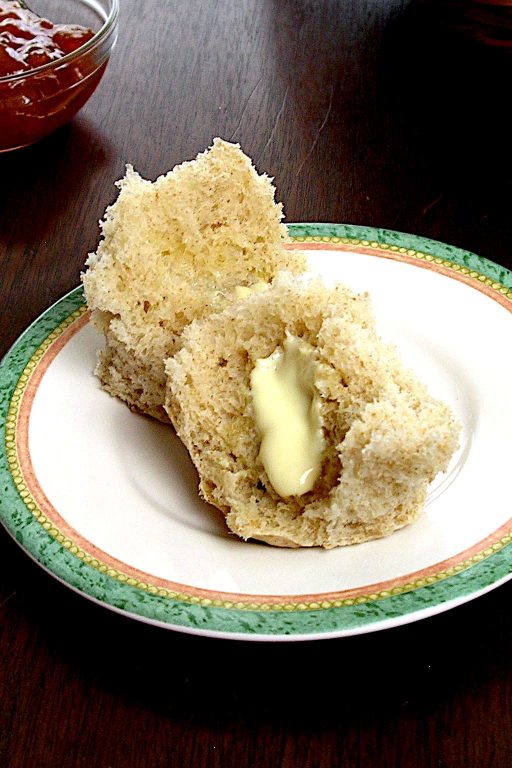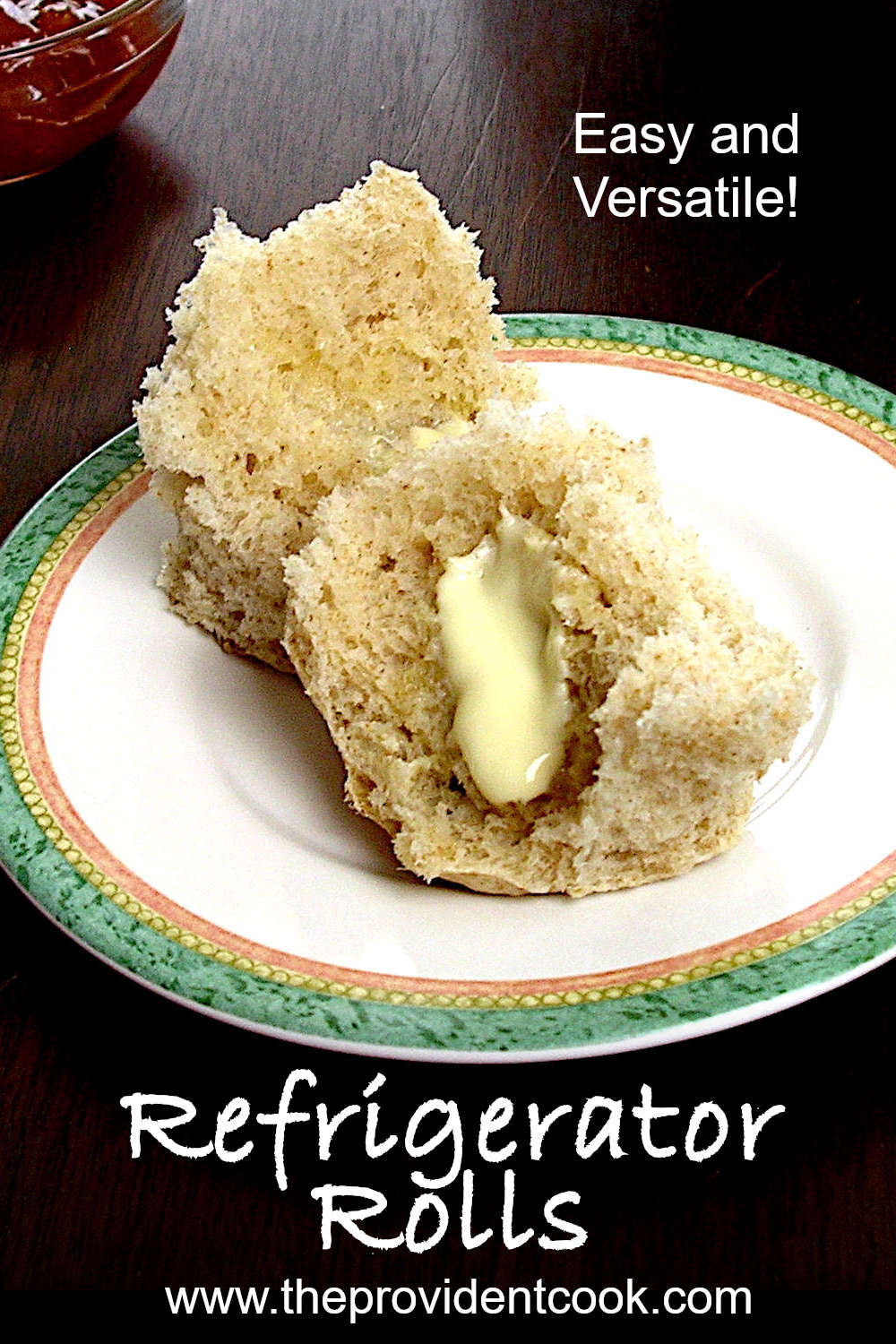Refrigerator rolls are the most versatile sweet roll recipe ever! Use the dough for dinner rolls, or shape them smaller to use as slider buns. Form the dough into cinnamon rolls or sticky buns. Or, store the dough in the refrigerator and bake just what you need for each day’s dinner or supper.
I’ve been making this recipe most of my life, and it’s really quite easy! (Especially if you have a heavy-duty stand mixer.) I almost called this ‘never-fail rolls’ because, if you follow the recipe, they almost always come out light, fluffy and delicious.
In reality, I have messed up a few times over the many years I’ve been making refrigerator rolls. To (hopefully) spare you the same fate, here are the mistakes I’ve made, in no particular order:
- Substituting vegetable oil or butter for the shortening. Neither gives an acceptable result, IMHO, and the oil was a disaster
- Failing to let the melted shortening cool to lukewarm. It killed the yeast, and the rolls failed to rise
- Using a packet of yeast that was too close to (or past) its expiration date (like the above, the rolls didn’t rise)
- Adding much more flour than the recipe calls for, which is easy to do with a stand mixer, but results in hockey pucks, not rolls
What’s with the Name?
Yeah, I almost renamed this recipe, but stuck with the original name for history’s sake. This recipe came from my mom, and my best guess is that it was designed to fit the lifestyles of the 50s or 60s. Because you can store the dough in the refrigerator for up to a week, you can use just what you need to make fresh rolls for each evening’s meal.
When I was a kid, Mom had dinner on the table at 6 p.m. sharp. Every. Single. Day. I don’t know how she did it! But she made these refrigerator rolls pretty often, which meant she could form up the rolls and set them aside to rise in the afternoon, then bake and serve them fresh that evening. They do “sour” a bit if kept in the fridge for more than a day, though it’s not a true sourdough.
Making Refrigerator Rolls
Nowadays, I almost always make and bake the full recipe the same day, which is what I’ll show you here. A full recipe of the rolls will fill a 9 x 13 pan. While that sounds like a lot, the egg and shortening in the recipe help the rolls stay fresh for days.
Start by melting the shortening in a small bowl. About 30 seconds on high in the microwave will do it. Set it aside to cool. Next, in a large bowl or the bowl of a stand mixer, mix the warm water, yeast and sugar. The water should be around body temperature; check it with your finger or wrist to be sure it’s not too hot. Let this mixture stand for about 5 minutes until the yeast begins to bubble and foam.
Now add the egg, salt, and about 2 cups of the flour. Beat with a spoon or dough hook to combine, then add the lukewarm shortening and beat a minute or two to combine. Continue adding the flour in one-cup increments, beating or running the stand mixer after each addition. At first, the dough will look like this:
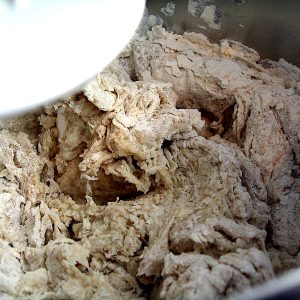
The dough looks all rough and shaggy at this point. Keep kneading by hand or running the stand mixer on low speed with the dough hook for at least five minutes to develop the gluten. If you’re kneading by hand, you may need to add more flour just to keep the dough from being too sticky to handle. If you’re using a stand mixer, add no more than a half-cup of extra flour.
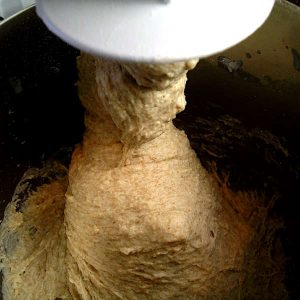
You can see my finished refrigerator roll dough above. This is considered a “slack dough,” i.e. the water-to-flour ratio, or hydration rate, is very high. If you’ve been baking for a while, you’ll probably think this dough is far too loose. But once it completes its first rise, the flour will fully hydrate and the dough becomes much easier to handle.
I usually set the dough to rise in the same bowl I used to make it; just pull or scoop the dough onto a plate that you’ve sprayed with cooking spray. (A dough scraper works great for this.) Wash and dry the mixing bowl, then spray it with cooking spray. Tip the dough into the cleaned and oiled bowl, then spray the top of it with cooking spray. (Sense a theme here? This dough will stick to almost anything you haven’t sprayed or oiled!) Cover the bowl with plastic wrap, and set it aside on the counter to rise for about an hour, or until it has doubled in size.
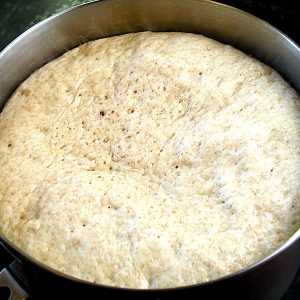
Once the dough has risen, oil your hands and gently deflate it. Now it’s time to form the rolls, and the first two steps are shown below. Oil your hands, then pull off a handful of dough about the size of a ping pong ball.
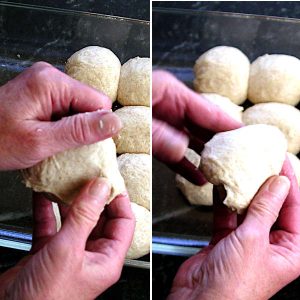
Use your thumbs to gently stretch the dough out, as shown at left. This forms a “gluten cloak” for the roll that helps give it its shape. Then, using your thumbs and fingertips, tuck the edges of the roll under, as shown at right. The last step (not shown) is to turn the formed dough over and pinch the bottom seams together. Turn the roll back over, and place it top-side up in an oiled or sprayed 9 x 13 baking dish.
I usually place a row of about four rolls across the narrow end of the dish, and about six or seven rows in total. Spray or oil a piece of plastic wrap and drape it over the top of the baking dish, not touching the rolls. Set the baking dish aside and allow the rolls to rise for at least a half-hour, or until doubled in size.
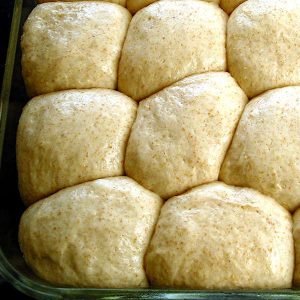
Toward the end of the rise time, preheat the oven to 350° F. When the rolls have finished rising, pop the pan into the oven and bake about 30 minutes, or until tops are browned and rolls are starting to pull away from the sides of the pan. After removing the rolls from the oven, let them rest for a few minutes. While they’re still hot, rub the tops with a tablespoon of butter or margarine on a piece of waxed paper or aluminum foil. This will help keep the tops soft and moist.
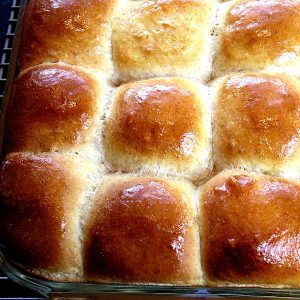
A Few Notes
If you decide to refrigerate the raw dough, be sure to check it at least twice a day to be sure it doesn’t overflow the bowl. If it’s getting close to overflowing, gently punch it down and return it to the fridge. After you’ve formed the cold dough into rolls, you’ll need to give them a little longer to rise – about an hour.
To make slider rolls, form the rolls much smaller, about the size of a large marble. Space the slider rolls about half an inch apart on all sides to let them rise wider and lower. Reduce your baking time too, probably to about 20 minutes.
I’ll post on how to make cinnamon rolls and sticky buns early next year.
PrintRefrigerator Rolls
Refrigerator rolls are the most versatile sweet roll recipe ever! Use the dough for dinner rolls, or shape them smaller to use as slider buns. Form the dough into cinnamon rolls or sticky buns. Or, store the dough in the refrigerator and bake just what you need for each day’s dinner or supper.
- Prep Time: 120
- Cook Time: 30
- Total Time: 2 hours 30 minutes
- Yield: about 24 rolls 1x
- Category: bread
- Method: baking
- Cuisine: American
Ingredients
1/4 cup shortening, melted and cooled
2 cups warm water (not over 100°)
1/2 cup sugar, scant (fill the measuring cup then remove a couple of teaspoons)
1 large egg
4 cups all-purpose flour (up to 4 1/2 if needed)
1 cup whole-wheat flour (or another cup of all-purpose flour)
Instructions
In a small bowl, microwave the shortening for about 30 seconds on high until mostly melted. Set aside to cool.
In a large bowl or the bowl of a stand mixer, mix the warm water, yeast, and sugar. Let stand for about 5 minutes until the yeast begins to bubble and foam.
Add the egg, salt, and about 2 cups of the flour. Beat with a spoon or run the mixer with a dough hook to combine, then add the lukewarm shortening and beat a minute or two to combine. Continue adding the flour in one-cup increments, beating or kneading by hand or running the stand mixer on low after each addition to fully incorporate. Resist the urge to add more than 5 total cups of flour, though you may add up to 1/2 cup more if needed. The finished dough should be slack, or slightly loose, or the rolls will be tough and dry.
Spray a large bowl with cooking spray and scrape and pull the finished dough into it. Spray the top of the dough with cooking spray, cover the bowl with plastic wrap, and set it aside to rise for about an hour, or until it has doubled in size.
Spray a 9 x 13-inch baking dish with cooking spray. Once the dough has risen, oil your hands and gently deflate it. Pull off a handful of dough, about the size of a ping pong ball, and form it into a roll. Place each formed roll into the prepared baking dish, spacing them closely.
When all the rolls are formed and in the baking dish, spray or oil a piece of plastic wrap and drape it loosely over the top dish, not touching the rolls. Set the baking dish aside and allow the rolls to rise for at least a half-hour, or until doubled in size.
Toward the end of the rise time, preheat the oven to 350° F. When the rolls have finished rising, place the pan into the oven and bake about 30 minutes, or until tops are browned and rolls are starting to pull away from the sides of the pan. After removing the rolls from the oven, let them rest for a few minutes. While they’re still hot, rub the tops with a tablespoon of butter or margarine on a piece of waxed paper or aluminum foil.
Notes
After you’ve made the dough, you can place the covered bowl in the refrigerator and use the dough as you need it for up to 7 days. Just be sure to check at least twice a day to be sure the dough doesn’t overflow the bowl. If it looks close to overflowing, just gently punch the dough down, re-cover the bowl, and place it back in the fridge.
Keywords: refrigerator rolls, sweet rolls, dinner rolls

